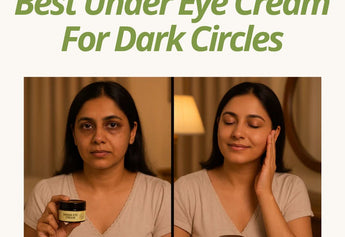Makeup can do wonders, but it does not work 24/7. Dark spots, pigmentation, and eye problems such as dark circles and puffy eyes tend to arise regardless of our attempts to cover them up. Stress, fatigue, lack of sleep, age, sun exposure, or dry skin are just a few causes of these problems. Puffy eyes and dark circles are quite commonly mixed up as if they are essentially one condition, whereas in reality they're separate complaints requiring a range of distinct approaches. Following are some comparisons of the difference between puffy eyes and dark circles, followed by treatments.
What Are Puffy Eyes?
Puffy eyes are puffiness or swelling of the eyes when one's body is fatigued, old, or under stress. Puffiness is caused by retained fluid beneath the eyelids, making one's face look as if it has not slept well and puffy. Crying, smoking, salt, or allergies cause the condition, but they are readily available to everyone. Puffy eyes are not harmful but can ruin your confidence and looks. With time, not sleeping or not doing something about the cause can make them more prominent.
What are dark circles?
Dark circles are skin pigmentation below the inferior edge of the eyelid, or more commonly, along the suborbital fold. It is commonly confused with puffy eyes since the two commonly coexist, but while dark circles aren't swelling themselves, they resemble fatigue or drooping and, more visibly, ill-looking due to the fact that they are presentations by color alterations within the skin. Causes also include lack of sleep, stress, dehydration, genetics, or skin thinning due to aging. Dark circles are a more established condition due to life or hereditary problems and therefore are more challenging to mend.
Puffy Eyes vs. Dark Circles: Major Differences
Puffy Eyes: Its causes are poor sleep, weeping crying, too much salt in the diet, or hormonal changes (like menstruation). The puffiness is caused by retained fluid in the thin layers of the eyes that appears in the form of swelling and tired eyes appearing and disappearing throughout the day.
Dark Circles: Dark circles entail discoloration of the eye area skin, from subtle shadows to dark, noticeable colors (blue, purple, or brown, respectively, depending on the color of your skin). They're typically an old condition with issues of bad sleep, genetics, thinning of the skin, or circulatory issues. Dark circles appear more noticeable with age as the skin loses collagen and becomes thinner, causing the superficial blood vessels to be noticeable. The best eye cream for dark circles by Oak Tree Naturals can help you in this. Puffy eyes are slightly more swollen, whereas dark circles are slightly more vascular or color-altered.
While dark circles and swollen eyes both look tired, they are caused by different reasons and need specialized treatment. Although it is possible that they could occur together, understanding their distinction is necessary if one wants to treat them separately.
How to Get Rid of Puffy Eyes
Puffy eyes will most likely improve significantly with fast and easy treatments that drain off excess fluid and swelling. Use the following remedies to cure them:
Cold Compresses: Rest your eyes on a cold spoon, a cold damp cloth, or even fridge-gel pads for 10-15 minutes.
Hydration: Get 8-10 glasses of water per day to help your body purge excess salt, one of the common culprits of water retention. Herbal teas like chamomile also soothe inflammation and give you fluids.
Rest: Sleep in a head-higher-than-heart position on an extra pillow to prevent fluid from gathering under your eyes while sleeping.
Lifestyle Changes: Reduce smoking and alcohol consumption, which dehydrate the body and lead to puffiness. Limit salt intake, and if there is an allergy, take antihistamines or consult a physician for the management of such allergens as pollen or dust.
How to Minimize Dark Circles
Dark circles typically require a systemic, long-term solution to their pigmentation and accountable etiology. The following are step-by-step approaches to minimizing them:
Skincare: Spend money on eye creams that have active ingredients such as aloe vera, vitamin C, or hyaluronic acid (to moisten and firm the skin).
Sleep: Embrace a regular sleeping routine such as 7-9 hours at night to avoid letting fatigue allow those dark circles under the eyes to darken.
Diet: Consume a diet rich in antioxidants and iron, which improves skin texture and oxygenation to reduce the bluish hue of visible blood vessels.
Sun Protection: Use a broad-spectrum SPF 30+ sunscreen in the sun area around the eyes daily, or use ultraviolet light-blocking glasses to shield the skin from ultraviolet damage induced by sunlight that darkens pigment.
Natural Remedies: Place cooled slices of cucumber or cooled and soaked tea bags over your eyes for 10-15 minutes in an effort to temporarily reduce blood vessels and dull color. You can also use Oak Tree Natural's best eye cream for dark circles.




